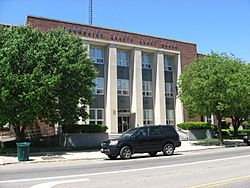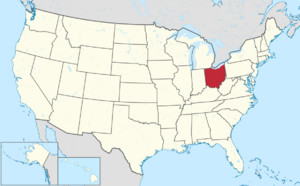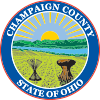Champaign County, Ohio facts for kids
Quick facts for kids
Champaign County
|
|||
|---|---|---|---|

Champaign County Courthouse in Urbana
|
|||
|
|||

Location within the U.S. state of Ohio
|
|||
 Ohio's location within the U.S. |
|||
| Country | |||
| State | |||
| Founded | March 1, 1805 | ||
| Named for | "plain" in French | ||
| Seat | Urbana | ||
| Largest city | Urbana | ||
| Area | |||
| • Total | 430 sq mi (1,100 km2) | ||
| • Land | 429 sq mi (1,110 km2) | ||
| • Water | 1.2 sq mi (3 km2) 0.3%% | ||
| Population
(2020)
|
|||
| • Total | 38,714 | ||
| • Density | 90.0/sq mi (34.8/km2) | ||
| Time zone | UTC−5 (Eastern) | ||
| • Summer (DST) | UTC−4 (EDT) | ||
| Congressional district | 4th | ||
Champaign County is a county located in the U.S. state of Ohio. As of the 2020 census, the population was 38,714. Its county seat and largest city is Urbana. The county takes its name from the French word for "open level country". Champaign County became the 18th of 88 Ohio counties on March 1, 1805. It was formed from parts of Greene and Franklin counties by legislative action. Champaign County comprises the Urbana, OH Micropolitan Statistical Area, which is also included in the Dayton–Springfield–Sidney, OH Combined Statistical Area.
Contents
Geography
According to the U.S. Census Bureau, the county has a total area of 430 square miles (1,100 km2), of which 429 square miles (1,110 km2) is land and 1.2 square miles (3.1 km2) (0.3%) is water.
Adjacent counties
- Logan County (north)
- Union County (northeast)
- Madison County (southeast)
- Clark County (south)
- Miami County (southwest)
- Shelby County (northwest)
Demographics
| Historical population | |||
|---|---|---|---|
| Census | Pop. | %± | |
| 1810 | 6,303 | — | |
| 1820 | 8,479 | 34.5% | |
| 1830 | 12,131 | 43.1% | |
| 1840 | 16,721 | 37.8% | |
| 1850 | 19,782 | 18.3% | |
| 1860 | 22,698 | 14.7% | |
| 1870 | 24,188 | 6.6% | |
| 1880 | 27,817 | 15.0% | |
| 1890 | 26,980 | −3.0% | |
| 1900 | 26,642 | −1.3% | |
| 1910 | 26,351 | −1.1% | |
| 1920 | 25,071 | −4.9% | |
| 1930 | 24,103 | −3.9% | |
| 1940 | 25,258 | 4.8% | |
| 1950 | 26,793 | 6.1% | |
| 1960 | 29,714 | 10.9% | |
| 1970 | 30,491 | 2.6% | |
| 1980 | 33,649 | 10.4% | |
| 1990 | 36,019 | 7.0% | |
| 2000 | 38,890 | 8.0% | |
| 2010 | 40,097 | 3.1% | |
| 2020 | 38,714 | −3.4% | |
| U.S. Decennial Census 1790-1960 1900-1990 1990-2000 2020 |
|||
2010 census
As of the 2010 United States Census, there were 40,097 people, 15,329 households, and 10,925 families living in the county. The population density was 93.5 inhabitants per square mile (36.1/km2). There were 16,755 housing units at an average density of 39.1 units per square mile (15.1 units/km2). The racial makeup of the county was 94.7% white, 2.2% black or African American, 0.4% Asian, 0.4% American Indian, 0.4% from other races, and 1.9% from two or more races. Those of Hispanic or Latino origin made up 1.1% of the population. In terms of ancestry, 27.6% were German, 14.9% were Irish, 14.3% were American, and 11.8% were English.
Of the 15,329 households, 33.7% had children under the age of 18 living with them, 55.9% were married couples living together, 10.2% had a female householder with no husband present, 28.7% were non-families, and 23.9% of all households were made up of individuals. The average household size was 2.56 and the average family size was 3.02. The median age was 39.7 years.
The median income for a household in the county was $49,246 and the median income for a family was $58,433. Males had a median income of $44,920 versus $32,847 for females. The per capita income for the county was $23,438. About 10.0% of families and 12.9% of the population were below the poverty line, including 18.4% of those under age 18 and 6.3% of those age 65 or over.
2020 census
As of the 2020 census, there were 38,714 people, and 15,506 households in the county. The population density was 90.2 people per square mile (34.8 people/km2). The racial makeup of the county was 94.4% White, 2.2% African American, 0.5% Asian, 0.5% Native American, and 2.4% two or more races. Those of Hispanic or Latino origin made up 1.8% of the population.
22% of the population was under 18, and 5.4% were under 5. 18.7% of the population were over 65. 50% of the population was female, and 50% was male.
The median income for a household in the county was $62,865. The per capita income for the county was $30,090. 10.6% of the population were below the poverty line.
Communities
City
- Urbana (county seat)
Villages
Townships
- Adams
- Concord
- Goshen
- Harrison
- Jackson
- Johnson
- Mad River
- Rush
- Salem
- Union
- Urbana
- Wayne
Census-designated place
Unincorporated communities
- Bowlusville
- Cable
- Carysville
- Catawba Station
- Crayon
- Darnell
- Eris
- Five Points
- Fountain Park
- Grandview Heights
- Kennard
- Kingscreek
- Lippincott
- Middletown
- Millerstown
- Mingo
- Northville
- Powhattan
- Springhills
- Terre Haute
- Thackery
- Westville
Libraries
The following libraries serve the communities of Champaign County.
- Champaign County Library in Urbana, Ohio and North Lewisburg, Ohio
- Mechanicsburg Public Library in Mechanicsburg, Ohio
- St. Paris Public Library in St. Paris, Ohio and Christiansburg, Ohio
Notable people
- Lawrence Borst, veterinarian and Indiana state legislator
- John Isaiah Caldwell, lawyer
- Jim Jordan, U.S. Representative for Ohio's 4th congressional district
- Michael Kent, comedian and magician
- Matt Rife, comedian
- David Taylor, Olympic gold medalist wrestler
See also
 In Spanish: Condado de Champaign (Ohio) para niños
In Spanish: Condado de Champaign (Ohio) para niños




